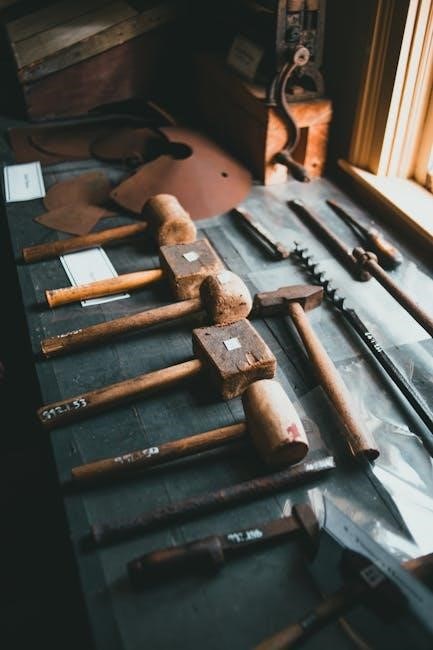Aged care manual handling equipment encompasses a diverse range of tools and devices designed to assist caregivers in safely moving and supporting elderly residents. This equipment aims to reduce physical strain and prevent injuries.
Importance of Safe Manual Handling in Aged Care
Safe manual handling is paramount in aged care to protect both caregivers and residents. Proper techniques and equipment minimize the risk of musculoskeletal disorders (MSDs) in staff, such as back injuries and strains. For residents, safe handling prevents falls, pressure sores, and discomfort. Implementing these practices enhances overall well-being, improves quality of life, ensures compliance with safety regulations, and fosters a supportive and caring environment within aged care facilities, ensuring a safe environment.
Overview of Manual Handling Tasks in Aged Care
Manual handling tasks in aged care involve a variety of activities, including assisting residents with transfers between beds, chairs, and wheelchairs. Repositioning patients in bed to prevent pressure sores, providing walking or mobility assistance, and aiding with toileting and personal care are also common. These tasks require caregivers to lift, support, and guide residents, often involving repetitive movements and potentially awkward postures. Proper training and equipment are essential to minimize the physical demands and risks associated with these activities.
Risks Associated with Poor Manual Handling Practices
Poor manual handling can lead to severe consequences. Risks include injuries to healthcare workers, such as musculoskeletal disorders, and potential harm to residents, like falls or pressure sores.
Musculoskeletal Disorders (MSDs) in Caregivers
Caregivers are at high risk of developing Musculoskeletal Disorders (MSDs) due to the physically demanding nature of their work. These disorders often result from repetitive movements, awkward postures, and the manual handling of residents. Common MSDs include back injuries, shoulder strains, and repetitive strain injuries. Proper manual handling techniques, training, and equipment are essential to mitigate these risks and protect caregivers’ well-being and health during their work.
Potential Harm to Residents
Poor manual handling practices not only endanger caregivers but also pose significant risks to residents. Improper lifting or transferring techniques can lead to falls, bruising, skin tears, and fractures in older adults. Residents with mobility issues or fragile bones are particularly vulnerable. Prioritizing safe manual handling through training and equipment reduces the potential for injury, ensuring the safety, comfort, and well-being of residents in aged care facilities.
Types of Manual Handling Equipment
Various types of manual handling equipment are available to aid caregivers, including wheelchairs, stretchers, slide sheets, transfer boards, mobile hoists, and ceiling hoists. Each serves a specific purpose in assisting with resident mobility and transfers.
Wheelchairs and Stretchers
Wheelchairs provide mobility for residents who have difficulty walking, while stretchers are used for transporting individuals who are unable to sit upright or require a lying position. These tools are essential for ensuring the safe and comfortable movement of residents within aged care facilities, offering support and reducing the risk of falls or further injury during transportation between different locations or activities.
Slide Sheets and Transfer Boards
Slide sheets and transfer boards are invaluable aids for safely moving residents between surfaces, such as beds and wheelchairs. Slide sheets reduce friction, enabling caregivers to reposition residents with minimal effort and discomfort. Transfer boards bridge gaps, providing a smooth surface for residents to slide across, facilitating independent transfers or assisted movement with reduced strain on both the resident and the caregiver.
Mobile and Ceiling Hoists
Mobile and ceiling hoists are essential tools for safely lifting and transferring residents with limited mobility. Mobile hoists offer flexibility and can be easily moved between rooms, while ceiling hoists provide a more permanent solution, maximizing space and ensuring smooth, controlled transfers. Both types of hoists significantly reduce the physical strain on caregivers, minimizing the risk of musculoskeletal injuries and promoting resident comfort and safety during transfers.

Manual Handling Training for Caregivers
Comprehensive manual handling training is crucial for caregivers to minimize injury risks when assisting residents. This training should cover safe lifting techniques, equipment usage, and understanding individual resident needs for optimal care.
Essential Techniques for Safe Lifting and Transferring
Safe lifting and transferring techniques are paramount in aged care to protect both caregivers and residents. Key elements include maintaining proper posture with a straight back, utilizing leg muscles for lifting, and avoiding twisting motions. Caregivers must also learn to assess the resident’s capabilities and use appropriate assistive devices, such as slide sheets or transfer boards, to minimize strain and ensure a smooth, secure transfer, while communicating clearly with residents to promote cooperation and comfort.
Employer and Employee Obligations Regarding Training
Employers in aged care have a legal and ethical obligation to provide comprehensive manual handling training to all staff. This training should cover safe lifting techniques, proper use of equipment, and risk assessment procedures. Employees, in turn, are responsible for actively participating in training, adhering to learned techniques, and reporting any potential hazards or equipment malfunctions. Both parties must collaborate to ensure a safe working environment, minimizing the risk of injuries associated with manual handling tasks, thus promoting well-being for both caregivers and residents.
Moving and Handling Risk Assessments
Moving and handling risk assessments are crucial for identifying potential injury risks in aged care settings. These assessments help in developing strategies to minimize harm to both caregivers and residents during manual handling tasks.
Identifying Potential Injury Risks
Identifying potential injury risks involves a thorough evaluation of manual handling tasks performed in aged care. This includes assessing the weight of residents, the frequency of transfers, awkward postures, and environmental factors. Recognizing these risks allows for targeted interventions. This process also assists in creating safer work practices, proper training, and the selection of appropriate manual handling equipment. Ultimately, this reduces the likelihood of musculoskeletal disorders among caregivers.
Implementing Preventative Measures
Implementing preventative measures requires a proactive approach to mitigating identified manual handling risks. This involves using appropriate manual handling equipment such as hoists, slide sheets, and transfer boards to reduce physical strain. Providing comprehensive training on safe lifting techniques, proper posture, and the use of assistive devices is also essential. Regular equipment maintenance and safety checks further ensure the ongoing effectiveness of these preventative strategies. Adjusting environmental factors can improve resident safety.

Legal Responsibilities and Compliance
Adhering to legal responsibilities and ensuring compliance with regulations like the Work Health and Safety (WHS) Act 2011 are crucial in aged care; These mandates safeguard both caregivers and residents.
Work Health and Safety (WHS) Act 2011
The Work Health and Safety (WHS) Act 2011 places the legal responsibility for workplace safety squarely on the employer and employee, emphasizing the need for safe manual handling practices. Employees must take reasonable care to ensure their own health and safety, alongside their coworkers and patients. Compliance reduces workplace risks and promotes well-being in aged care facilities.
Policies and Procedures in Residential Aged Care Facilities
Residential aged care facilities require comprehensive policies and procedures to address manual handling risks effectively. These procedures should include risk assessments, safe lifting techniques, and the proper use of manual handling equipment. Regular reviews and updates are crucial to ensure policies align with current best practices and regulations. Training programs for staff must also be incorporated to foster a safe working environment.
The Role of Assistive Technology
Assistive technology plays a vital role in aged care by enhancing the safety and efficiency of manual handling tasks. It provides support for caregivers and improves the overall quality of life for residents.
Unique Requirements of Aged Care Facilities
Aged care facilities present unique manual handling challenges due to the varying physical abilities and health conditions of residents. Assistive technology must cater to diverse needs, including mobility limitations, cognitive impairments, and specific medical conditions. Solutions must be adaptable, easy to use, and integrate seamlessly into the care environment to ensure both resident safety and caregiver well-being during transfers, repositioning, and daily activities.
Tailored Solutions for Efficient Care
Efficient care in aged care facilities necessitates the implementation of tailored manual handling solutions that address specific needs and challenges. This involves selecting the appropriate equipment, such as hoists, slings, and transfer aids, based on resident assessments and care plans. Furthermore, training caregivers in the correct usage of equipment and implementing standardized procedures can optimize workflow, minimize risks, and promote a safe, comfortable environment for both residents and staff.
Innovative Technologies for Manual Handling
Innovative technologies are transforming manual handling in aged care. These advancements include wearable sensors like dorsaVi, which monitor movement. These tools improve safety, reduce injuries, and enhance care quality for residents and staff.
Wearable Sensor Technology (e.g., dorsaVi)
Wearable sensor technology, such as dorsaVi, represents a significant advancement in aged care manual handling. These sensors can be attached to caregivers to monitor their movements, posture, and muscle activity during patient handling tasks. The data collected helps identify high-risk movements and potential injury risks. This technology supports real-time feedback and allows for targeted training and interventions. It ultimately reduces musculoskeletal disorders and improves workplace safety.
Benefits of Using Sensor Technology in Aged Care
The implementation of sensor technology in aged care offers numerous advantages. It provides objective data on manual handling techniques, enabling personalized training programs for caregivers. This technology facilitates early detection of poor movement patterns, reducing the risk of musculoskeletal injuries. Furthermore, it improves caregiver awareness of their own body mechanics. By monitoring and analyzing data, sensor technology enhances resident safety during transfers, repositioning, and other manual handling tasks, ultimately promoting a safer working environment.
Manual Handling Principles
Effective manual handling is vital. It reduces staff injuries and prevents patient harm. Proper techniques are essential for lifting, transferring, and repositioning residents. Training ensures caregivers use safe methods consistently, protecting themselves and those they care for.
Proper Posture and Body Mechanics
Maintaining proper posture and utilizing correct body mechanics are fundamental principles in aged care manual handling. Caregivers should stand or sit upright, preserving the spine’s natural curves. Feet should be wide apart to provide a stable base, ensuring balance during lifting and transferring tasks. Bending at the knees, not the waist, protects the back from strain; By adhering to these principles, caregivers minimize the risk of musculoskeletal injuries and ensure safer handling practices for both themselves and residents.
Feet Placement and Spine Alignment
Optimal feet placement and spine alignment are critical for safe and effective manual handling in aged care. Caregivers must position their feet shoulder-width apart, creating a stable base of support. Maintaining the spine’s natural curves, rather than bending or twisting, is crucial. This posture reduces stress on the back and enhances balance. Proper alignment ensures that the strongest muscles are engaged during lifting and transferring tasks, minimizing the risk of injuries for both the caregiver and the resident they are assisting.
Specific Manual Handling Scenarios and Solutions
Addressing varied situations, this section provides practical solutions for common manual handling tasks in aged care. It offers guidance on safely assisting residents with mobility, transfers, and other daily activities to prevent injury.
Assisting Residents Out of Bed
Assisting residents out of bed requires careful planning and execution to ensure both caregiver and resident safety. Employing proper techniques, such as using bed rails for support and encouraging resident participation, is essential. Adjustable beds, swivel chairs, and transfer boards can further facilitate the process. Always assess the resident’s abilities and use appropriate manual handling equipment to minimize the risk of injury. Clear communication is key.
Helping Residents into Chairs or Wheelchairs
Assisting residents into chairs or wheelchairs necessitates a comprehensive understanding of safe transfer techniques and appropriate equipment utilization. Transfer boards and swivel discs can aid in bridging the gap between surfaces. Ensure the chair or wheelchair is stable and properly positioned before initiating the transfer. Encourage residents to participate actively, while providing support as needed. Always prioritize clear communication and maintain a steady, controlled movement to prevent falls or injuries.
Guiding Residents During Walks
Guiding residents during walks demands careful attention to balance and stability. Utilizing gait belts provides a secure point of contact for support and directional guidance. Maintain a close proximity to the resident, adjusting your pace to match their capabilities. Scan the environment for potential hazards, such as uneven surfaces or obstacles. Encourage the resident to maintain an upright posture and use assistive devices like walkers or canes if needed. Clear communication and gentle encouragement can promote confidence and safety during ambulation.

Equipment Maintenance and Safety Checks
Regular maintenance and safety checks are vital for aged care manual handling equipment. This ensures proper functionality, prolongs equipment lifespan, and guarantees resident and caregiver safety. Consistent inspections identify potential hazards and facilitate timely repairs;
Regular Inspection Procedures
Implementing routine inspection procedures is crucial for maintaining the safety and effectiveness of manual handling equipment in aged care. These procedures should include visual checks for damage, wear, and tear, as well as functional tests to ensure equipment operates as intended. Documenting these inspections is essential for tracking maintenance and identifying potential issues before they escalate into safety hazards, protecting both residents and caregivers. Inspections by trained personnel will help maintain a safe environment.
Ensuring Equipment Functionality
Maintaining the functionality of manual handling equipment in aged care requires regular servicing and timely repairs. Caregivers should be trained to identify signs of malfunction and report them promptly. Scheduled maintenance checks by qualified technicians are essential to ensure equipment operates safely and effectively. Proper storage and handling of equipment also contribute to its longevity and reliable performance, minimizing the risk of accidents and ensuring the well-being of both residents and staff.
Benefits of Using Manual Handling Equipment
Utilizing manual handling equipment in aged care significantly enhances safety. It reduces the physical demands on caregivers and lowers the risk of musculoskeletal injuries. Residents experience improved comfort and dignity during transfers and movements.
Reduced Risk of Injuries for Staff
Manual handling equipment plays a vital role in minimizing the physical strain on aged care staff. By utilizing tools like hoists, slide sheets, and transfer boards, caregivers can reduce the risk of musculoskeletal disorders (MSDs) such as back injuries and shoulder strains. Proper equipment usage enables safe transfers and repositioning of residents, preventing overexertion and promoting a healthier, safer working environment for all staff members. This ultimately leads to improved job satisfaction and reduced staff turnover.

Promoting a Safe Aged Care Environment
Improved Resident Safety and Comfort
Manual handling equipment significantly enhances resident safety and comfort during transfers and repositioning; Devices like wheelchairs, stretchers, and ceiling hoists provide secure and stable support, reducing the risk of falls or accidental injuries. Proper use of this equipment ensures gentle and dignified handling, minimizing discomfort and anxiety for residents. By eliminating manual lifting, caregivers can provide smoother, more controlled movements, fostering a sense of security and well-being for those in their care, and further promoting comfort for residents.